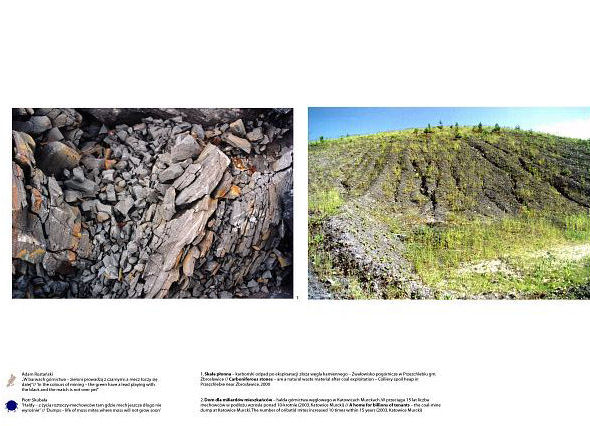
Description popularizing the research project
Lichen are well-known pioneers. They look like a wrinkled crust stuck to rocks. Grasping at tiny cracks they prepare a layer of soil for other plants. They are simply irreplaceable in this role.
Nevertheless they will never settle down on post coal-mining heaps where they are needed the most, as they do not tolerate toxic compounds present in the ground, water and air. So they will not spread across over a hundred of such heaps in Silesia to help us reclaim them. It is enough to have a closer look at the heaps to realize that no reclamation is possible there. A thick layer of fine dust guarantees failure of any attempts to plant vegetation there. Below the choking dust, spoil rocks, companions of coal, lie buried. Only fossilized imprints of ferns and horsetails are silent witnesses of rich life gone long ago. Barren slate and dead sandstone seem to be enough to prevent anybody from planting trees there. Yet still a large part of the black hills are covered with green. The green is weak and stunted but still grasps desperately at more stable ground. These are birch trees strong enough to survive on the inhospitable and even hostile ground.
Years of researches on flora and fauna of the heaps show that any reclamation of the sites should be based upon the local stunted vegetation, as only the specimens selected in the harsh conditions are able to withstand the environment. Will the lichen keep their position in the vanguard of life? Or will they have to step down to make room for moss mites that laboriously prepare soil for birches, mignonettes and other plants and animals?
Abstract
The problem of ground degradation by industry and mining, particularly conspicuous in traditional bituminous coal mining areas, is among the most important ecological and economic challenges of the present day. In the Upper Silesia Coal Basin where mining has been developed since the mid-18th century, debris of waste rock and post-washing material of mining origin is accumulated as spoil heaps (dumps), known in Polish as "hałdy". Proper management of these areas by reconstructing the plant cover is currently a requirement under the law. On many unreclamated post-industrial spoil heaps in Upper Silesia, the vegetation has undergone spontaneous formation, often over the course of many years.
In the years 1989-2002, studies were carried out in the area of the Upper Silesia Coal Basin on 85 sites - spoil heaps of Carboniferous waste material. The aims of the studies presented here are as follows:
- presentation of an up-to-date, integrated picture of the spontaneously developing plant cover on mine spoil heaps in the area of Upper Silesia Coal Basin against the background of special habitat conditions existing there;
- characterisation of the principal abiotic factors which influence the process of spontaneous plant cover development on waste ground of mining origin;
- specification of the main stages in the process of spontaneous plant cover formation on spoil heaps of bituminous coal mining origin;
- drawing conclusions and making recommendations for optimal reclamation and management methods in mining spoil heap habitats, using the local plant resources (local gene potential) to the full extent.

